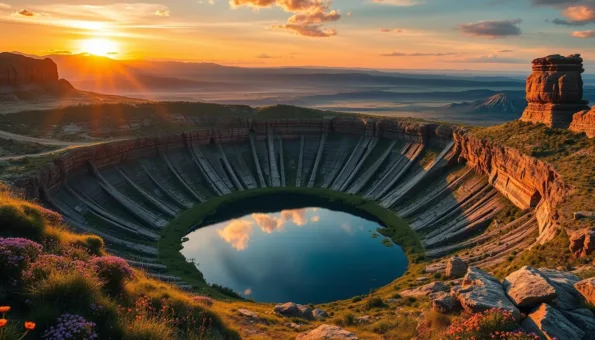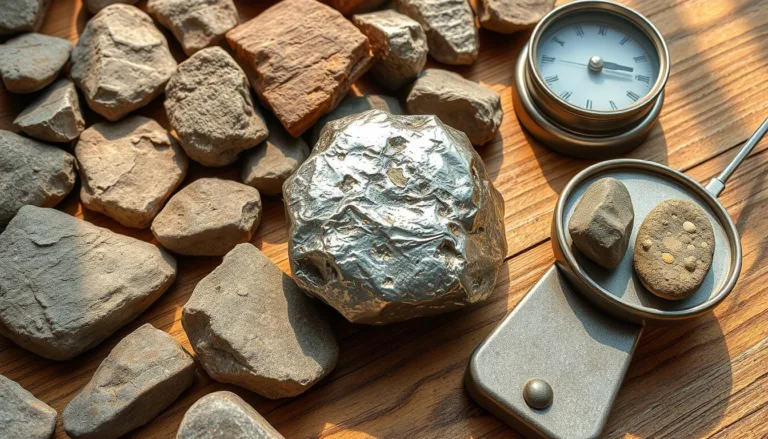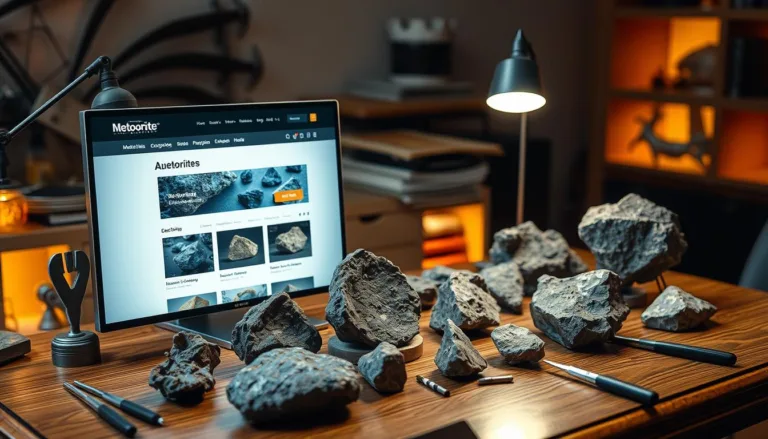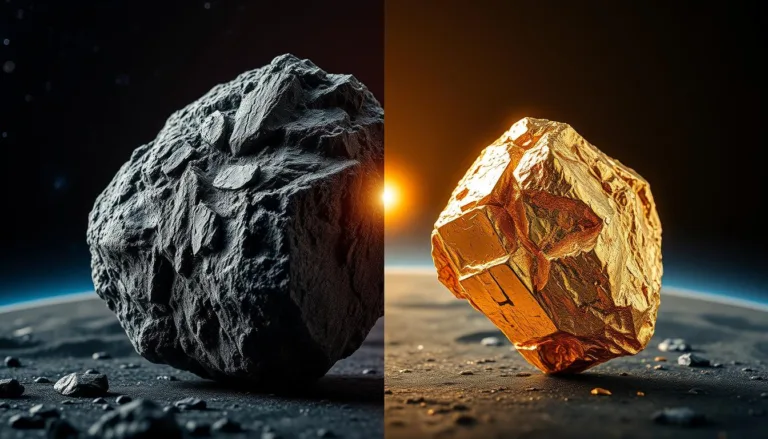Explore the fascinating world of meteorites, mysterious space rocks that have fascinated us for ages. We’ll delve into their origins, types, and importance in science. This will help us understand our universe better.
Meteorites are pieces of asteroids, comets, or planets that made it to Earth. They tell us a lot about our solar system’s early days. Scientists find them very useful for learning about our cosmic past.
Key Takeaways
- Meteorites are fragments of asteroids, comets, or other planetary bodies that have survived their journey through Earth’s atmosphere.
- These space rocks provide scientists with crucial information about the formation and evolution of our solar system.
- Meteorites are classified into three main categories: stony, iron, and stony-iron, each with its unique characteristics and scientific significance.
- Studying meteorites helps researchers understand the origins of life on Earth and the potential for extraterrestrial life elsewhere in the universe.
- Famous meteorite discoveries, such as the Tunguska Event and the Chelyabinsk Meteor, have had a profound impact on our understanding of the cosmos.
Understanding the Origins of Space Rocks: From Cosmic Debris to Earth
Meteorites are amazing space rocks that sometimes land on our planet. They have a long history that goes back to when our solar system was formed. These objects give us a peek into the universe.
Formation in the Asteroid Belt
Meteorites come from broken asteroids and other space junk. They were part of the asteroid belt, a place between Mars and Jupiter. Over time, they broke into smaller pieces due to collisions and gravity.
Journey Through Space
- As meteoroids travel, they might hit other objects or be pulled by big planets.
- Some might head towards Earth, while others keep exploring space for ages.
- The path they take can change their destination and create amazing sights like meteor showers.
Earth’s Atmosphere Entry Process
When a meteoroid hits Earth’s atmosphere, it faces intense heat and friction. This can make it break apart or even disappear. This process is what makes meteor showers and rare asteroid impacts so exciting.
| Phenomenon | Description |
|---|---|
| Meteor showers | They happen when Earth goes through the debris from a comet or asteroid. This creates a stunning show of shooting stars in the sky. |
| Asteroid impacts | These are rare but can cause big damage. They can even change the course of life on Earth. |
Learning about these space rocks helps us understand our solar system better. It shows us how dynamic and changing it is.
The Ultimate Guide to Meteorites: What They Are and Why They Matter
Meteorites are amazing natural wonders that fascinate scientists and space fans. They are key to understanding how our solar system formed and changed. By studying their makeup and structure, we learn new things about the universe.
Meteorites come from asteroids, comets, or other space bodies that made it to Earth. They are not just cool to look at but also very important for space research. They connect us to the start of our solar system, giving us clues about how planets and moons formed.
Scientists have made big discoveries by studying meteorites. They’ve learned a lot about our solar system’s start, the makeup of other planets, and if life exists elsewhere. Meteorites have helped find new minerals and organic compounds that might have helped life start on Earth.
| Meteorite Type | Composition | Significance |
|---|---|---|
| Stony Meteorites | Silicate minerals | Provide insights into the composition of the Earth’s mantle and the earliest stages of planetary formation. |
| Iron Meteorites | Nickel-iron alloys | Offer clues about the core formation processes of planets and the magnetic fields of celestial bodies. |
| Stony-Iron Meteorites | Mixture of silicate minerals and nickel-iron alloys | Shed light on the complex interactions between a planet’s core and mantle during the early stages of its formation. |
Meteorites are crucial for space research. They not only spark our curiosity but also connect us to our solar system’s past. They give us insights that help us understand the universe better.

“Meteorites are like time capsules, preserving the chemical and mineral signatures of the early solar system. By studying them, we gain unprecedented access to the building blocks of our planet and the other celestial bodies that surround us.”
Classifications and Types of Meteorites
Exploring the world of extraterrestrial minerals is fascinating. We must understand the different types of meteorites. These space rocks give us a peek into our solar system’s past.
Stony Meteorites
Stony meteorites are the most common. They are made mostly of silicate minerals like olivine and pyroxene. These rocks tell us about asteroids and how planets formed.
They show different textures. The outside is smooth from their fiery entry into Earth’s atmosphere. The inside reveals their origins.
Iron Meteorites
Iron meteorites are mostly iron and nickel. They give us a look at the cores of asteroids and planets. These heavy rocks are interesting to scientists and collectors.
They have unique chemical signs. These signs tell us about our solar system’s history.
Stony-Iron Meteorites
Stony-iron meteorites are a mix of stony and iron meteorites. They have both silicate minerals and metallic alloys. This mix is rare and lets us study how planets formed.
Learning about meteorites helps us understand our planet and the universe. Each type offers a unique view into space’s history.
| Meteorite Type | Composition | Key Characteristics |
|---|---|---|
| Stony Meteorites | Silicate minerals | Most common type, offer insights into asteroid composition and planet formation |
| Iron Meteorites | Iron and nickel alloys | Provide a glimpse into the metallic cores of differentiated asteroids and planets |
| Stony-Iron Meteorites | Mixture of silicate minerals and metallic alloys | Rare specimens that reveal the complex interactions between the two during planetary formation |
Scientific Value and Research Applications
Meteorites are incredibly valuable for space research. They help us learn about the universe. By studying them, we gain insights into space, scientific discoveries, and asteroid impacts.
The chemical makeup of meteorites tells us about our solar system’s past. Scientists study these samples to understand how planets formed. This knowledge helps us understand the planets and moons we see today.
Meteorites also help us look to the future. They are key in the development of asteroid mining. This new field could change how we get resources from space.
Meteorites are crucial for our ongoing space exploration. They help us figure out where life came from and if we can live on other planets. These space rocks inspire and guide our scientific discoveries.
“Meteorites are the only samples we have of the early solar system. They provide a unique window into the formation and evolution of planets, moons, and other celestial bodies.”
- Unraveling the Mysteries of Planetary Formation
- Advancing Asteroid Mining and Resource Extraction
- Exploring the Potential for Interplanetary Colonization
- Shedding Light on the Origins of Life
As we keep studying meteorites, their value will only grow. They will help us understand more about the universe and our place in it.
Famous Meteorite Discoveries and Their Impact on Science
Meteorites have fascinated scientists for centuries. They have led to major discoveries that changed how we see the universe. Events like the Tunguska event and the Chelyabinsk meteor have amazed the public and pushed science forward.
The Tunguska Event
In 1908, a huge explosion hit Siberia, destroying over 800 square miles of forest. No crater was found, but scientists knew a big meteorite or comet had exploded in the sky. This event, known as the Tunguska event, is a key moment in modern history, showing us the power of shooting stars and meteor showers.
The Chelyabinsk Meteor
In 2013, a 20-meter-wide meteor flew over Russia, breaking windows and hurting over 1,500 people. It was caught on many cameras, giving us a close look at a meteor entering Earth’s atmosphere. The Chelyabinsk meteor is now a key study for understanding meteor behavior and their dangers to people.
Historic Meteorite Collections
- The Smithsonian National Museum of Natural History in Washington, D.C., has over 50,000 meteorites from all over the world.
- The British Museum in London has a big collection, including the Willamette Meteorite, one of the biggest found in the U.S.
- The Meteorite Museum at the University of New Mexico in Albuquerque has a huge variety of meteorites for visitors to see.
These collections amaze the public and help scientists. They give researchers the tools they need to study our solar system and where life came from.

Conclusion
Meteorites are more than just cool space rocks. They are key to understanding our universe. They come from the asteroid belt and enter Earth’s atmosphere in a dramatic way. These visitors help us learn about our solar system’s past and how it changed.
By studying meteorites, we’ve learned a lot about our planets and how they were formed. We also understand how space impacts have shaped Earth’s history. This knowledge keeps pushing the boundaries of space exploration and science.
Meteorites are not just about science; they remind us of our connection to space. They spark our curiosity and make us wonder about the universe. As we learn more about these space rocks, we get closer to understanding our place in the universe.







